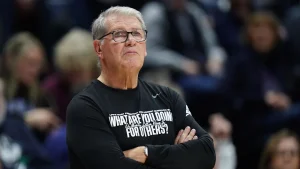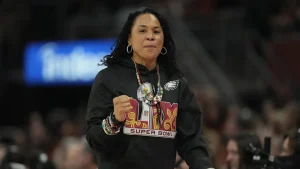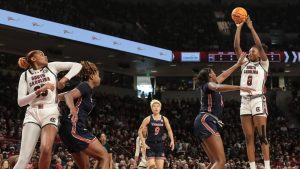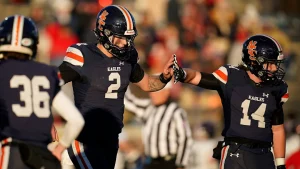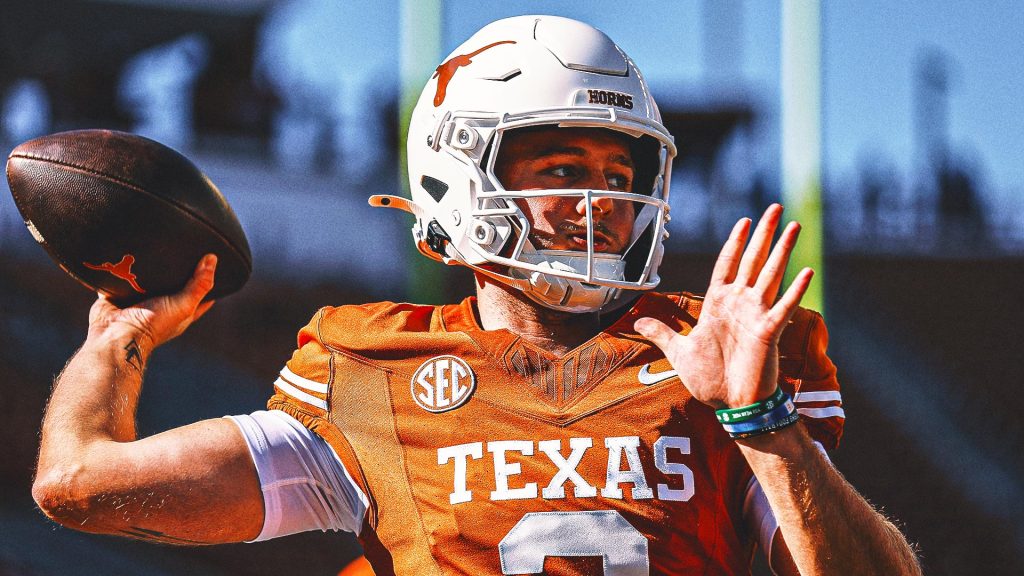
How the Texas football defense might change as a result of this transfer in 2025
The 2025 Texas Longhorns football team is set to undergo significant transformations, especially on the defensive side of the ball. With a series of impactful transfers, key recruitments, and coaching changes, the defense is positioned for substantial improvements. This article will explore how Texas football’s defense might evolve due to the impact of these transfers and other adjustments. We’ll break down the position groups, analyzing both the new talent brought in and the existing players who will need to step up for Texas to become a more dominant force in college football.
Defensive Line Reinforcements
The heart of any football defense often lies in its defensive line. Texas football has recognized this and made bold moves to strengthen its front line, which was a critical area of focus heading into the 2025 season. With key transfers coming in and some departures shaking things up, the defensive line will be a pivotal part of Texas’s defensive identity.
Travis Shaw – Defensive Tackle, North Carolina
Travis Shaw, a defensive tackle transfer from North Carolina, is one of the most significant additions to Texas’s defense for the 2025 season. Shaw stands at 6’5.5″ and weighs 330 pounds, making him an imposing figure in the middle of the defensive line. His size alone is enough to clog running lanes and disrupt the flow of the opposing offense. Shaw has experience at a high level, which will be essential as he transitions into the Texas system.
Shaw’s presence in the middle of the defensive line provides immediate depth and flexibility for Texas. With his size and ability to push the pocket, Shaw will make it difficult for offensive linemen to control the line of scrimmage, which is especially important in Big 12 play. Additionally, Shaw is expected to be a force in both the run and pass game, adding stability to a defensive line that has been inconsistent in recent years.
Hero Kanu – Defensive Tackle, Ohio State
Hero Kanu, another highly regarded defensive tackle, comes to Texas from Ohio State. At 6’5″ and 305 pounds, Kanu is slightly smaller than Shaw but still boasts a remarkable combination of size and athleticism. Kanu has experience in one of the nation’s top programs, and his ability to make plays at the line of scrimmage will help Texas significantly.
Kanu’s versatility allows him to play multiple spots on the defensive line, which will give defensive coordinator Pete Kwiatkowski more flexibility in his schemes. Whether it’s lining up as a traditional defensive tackle or shifting outside to rush the quarterback, Kanu has the ability to create havoc on opposing offenses. His presence also improves the depth of the defensive line, ensuring that Texas has fresh, talented players rotating in throughout the game.
Projected Impact on Defensive Line Play
The combination of Shaw and Kanu will have a significant impact on Texas’s defensive line. Both players are capable of controlling the line of scrimmage and limiting running backs’ yards per carry. Their size and skill will also help in rushing the passer, a critical area where Texas has struggled in recent seasons. Shaw’s ability to clog running lanes and Kanu’s pass-rushing potential make this duo an ideal fit for Texas’s defensive scheme. With these transfers, Texas now has a deep, talented defensive line that can disrupt offenses on every down.
Linebacker Enhancement
The linebacker position is another area where Texas made key improvements. The addition of Brad Spence, a transfer from Arkansas, brings leadership, athleticism, and versatility to the unit.
Brad Spence – Linebacker, Arkansas
Brad Spence, a linebacker who transferred from Arkansas, adds experience and physicality to the Texas linebacker corps. Standing at 6’2″ and weighing 238 pounds, Spence has the size and speed to cover both the run and pass. As a sophomore, Spence is poised to step into a starting role for the Longhorns, and his familiarity with the program will ensure a smooth transition.
Spence’s playmaking ability was evident during his time at Arkansas, and Texas will be looking to him to take on a leadership role in the linebacker room. As a versatile player, Spence can play inside or outside linebacker, giving Texas defensive coordinator Kwiatkowski flexibility in his defensive scheme. His ability to cover ground, shed blockers, and make plays in the backfield will be vital in ensuring that Texas has one of the most well-rounded linebacker groups in the Big 12.
Impact on Linebacker Group
The addition of Spence allows Texas to improve its linebacker depth and overall talent. With Spence, Anthony Hill Jr., and Liona Lefau, Texas now has a group of linebackers capable of making plays all over the field. Spence’s ability to read offenses and make timely tackles will help bolster the Texas defense, particularly in stopping the run and covering tight ends and running backs in the passing game.
Furthermore, Spence’s leadership will help mentor younger linebackers and ensure that the defensive unit plays cohesively. Texas’s linebackers will be a critical part of the team’s ability to contain opposing offenses, and Spence’s addition will be instrumental in achieving that goal.
Defensive Backfield Upgrades
The secondary, often a weakness in past seasons, will receive much-needed talent with the addition of Kade Phillips and others. These additions will provide Texas with more depth and versatility in the backfield, which is crucial for defending against the high-powered passing offenses in the Big 12.
Kade Phillips – Cornerback
Kade Phillips, a five-star recruit, is one of the top additions to Texas’s secondary. After flipping from LSU to Texas during the 2024 National Signing Day, Phillips will instantly become one of the most highly touted players in the Longhorns’ defensive backfield. As a cornerback, Phillips has the ability to lock down wide receivers and shut down passing lanes. His athleticism and ball skills make him a dangerous player, both in man coverage and zone schemes.
Phillips’s ability to disrupt passing games will be vital for Texas, especially as the team faces high-powered offenses in the Big 12. His presence will also free up other defensive backs, allowing them to play more aggressively knowing that Phillips can handle top-tier wide receivers on his own. As a true freshman, Phillips is expected to make an immediate impact, and his future at Texas looks incredibly bright.
Jay’Vion Cole – Safety
Jay’Vion Cole is another significant addition to the Texas secondary, bringing much-needed experience and versatility. Cole will provide depth at safety, a position that Texas has been thin at in recent seasons. Cole’s ability to cover ground and support the run game will help Texas in its efforts to stop explosive offenses. In addition, Cole’s experience in coverage will be critical in defending against mobile quarterbacks and dynamic wide receivers.
Overall Impact on the Secondary
With the addition of Phillips, Cole, and the continued development of existing players like Malik Muhammad, Texas now has a secondary capable of competing with the best in the Big 12. The versatility and talent within the secondary will allow Texas to match up better against teams with high-powered passing attacks. The increased depth also means that the defensive backs can rotate more effectively, keeping players fresh and ready to make plays throughout the game.
Departures and Adjustments
As with any team, transfers and player departures can shake up the roster. Texas has experienced a few key departures that will force the coaching staff to make adjustments.
Jaray Bledsoe – Defensive Lineman (Mississippi State)
The departure of defensive lineman Jaray Bledsoe to Mississippi State leaves a hole in Texas’s defensive front. Bledsoe was a key rotational player and provided depth on the defensive line. While his departure is a setback, Texas has a deep group of defensive linemen, so the team should be able to absorb this loss.
Derion Gullette – Edge Rusher (Mississippi State)
Edge rusher Derion Gullette’s decision to transfer to Mississippi State leaves another gap in Texas’s pass-rushing group. Gullette had shown flashes of brilliance but was inconsistent at times. His departure means that Texas will need to rely on other edge rushers to fill the void, particularly Justice Finkley and Trey Moore, who will need to step up and provide consistent pressure on opposing quarterbacks.
Coaching Staff Changes
Coaching changes can have a significant impact on a team’s performance, and Texas is no stranger to coaching turnover. Blake Gideon, who previously coached the safeties, left Texas for a defensive coordinator position at Georgia Tech. Scottie Hazelton, a special assistant to the head coach, also left to become the defensive coordinator at Wake Forest. These changes could lead to some shifts in the defensive philosophy and approach.
Despite these departures, Texas’s defensive coaching staff remains strong, with Pete Kwiatkowski continuing to lead the defense. Kwiatkowski’s ability to adapt and make adjustments based on personnel will be crucial for Texas as they look to build on the improvements made through the transfer portal and recruiting.
The Texas Longhorns defense is poised for a significant transformation in the 2025 season, thanks to key transfers like Travis Shaw, Hero Kanu, Brad Spence, and Kade Phillips, as well as other additions like Myron Charles and Jay’Vion Cole. These players will help strengthen Texas’s defensive line, linebacker corps, and secondary, providing the Longhorns with the talent and depth necessary to compete for championships in the Big 12 and beyond.
While departures like Jaray Bledsoe and Derion Gullette will require adjustments, the overall infusion of talent and leadership should lead to a much more formidable defense in 2025. With a deeper and more talented roster, Texas football is well-positioned to build a defense capable of matching up with some of the best offenses in the nation. The Longhorns’ defense in 2025 promises to be one of the most improved units in college football, and its success will be a key factor in Texas’s quest for a national title.
